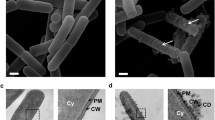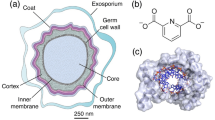Abstract
The survivability of Bacillus subtilis spores and vegetative Escherichia coli cells after electrospray from aqueous suspension was tested using mobility experiments at atmospheric pressure. E. coli did not survive electrospray charging and desolvation, but B. subtilis did. Experimental conditions ensured that any surviving bacteria were de-agglomerated, desolvated, and electrically charged. Based on mobility measurements, B. subtilis spores survived even with 2,000–20,000 positive charges. B. subtilis was also found to survive introduction into vacuum after either positive or negative electrospray. Attempts to measure the charge distribution of viable B. subtilis spores using electrostatic deflection in vacuum were inconclusive; however, viable spores with low charge states (less than 42 positive or less than 26 negative charges) were observed.

ᅟ






Similar content being viewed by others
References
Kebarle, P., Tang, L.: From ions in solution to ions in the gas-phase—the mechanism of electrospray mass-spectrometry. Anal. Chem. 65, A972–A986 (1993)
Siuzdak, G., Bothner, B., Yeager, M., Brugidou, C., Fauquet, C.M., Hoey, K., Chang, C.M.: Mass spectrometry and viral analysis. Chem. Biol. 3, 45–48 (1996)
Fuerstenau, S.D., Benner, W.H., Thomas, J.J., Brugidou, C., Bothner, B., Siuzdak, G.: Mass spectrometry of an intact virus. Angew. Chem. Int. Ed. 40, 542–544 (2001)
Thomas, J.J., Bothner, B., Traina, J., Benner, W.H., Siuzdak, G.: Electrospray ion mobility spectrometry of intact viruses. Spectrosc. Int. J. 18, 31–36 (2004)
Bothner, B., Siuzdak, G.: Electrospray ionization of a whole virus: analyzing mass, structure, and viability. Chem. Biochem. 5, 258–260 (2004)
Kim, K., Kim, W., Yun, S.H., Lee, J.H., Kim, S., Lee, B.U.: Use of an electrospray for the generation of bacterial bioaerosols. J. Aerosol Sci. 39, 365–372 (2008)
Kim, K., Lee, B.U., Hwang, G.B., Lee, J.H., Kim, S.: Drop-on-demand patterning of bacterial cells using pulsed jet electrospraying. Anal. Chem. 82, 2109–2112 (2010)
Hogan, C.J., Kettleson, E.M., Ramaswami, B., Chen, D.R., Biswas, P.: Charge reduced electrospray size spectrometry of mega- and gigadalton complexes: whole viruses and virus fragments. Anal. Chem. 78, 844–852 (2006)
Nicholson, W.L., Munakata, N., Horneck, G., Melosh, H.J., Setlow, P.: Resistance of bacillus endospores to extreme terrestrial and extraterrestrial environments. Microbiol. Mol. Biol. Rev. 64, 548–572 (2000)
Mainelis, G., Adhikari, A., Willeke, K., Lee, S.A., Reponen, T., Grinshpun, S.A.: Collection of airborne microorganisms by a new electrostatic precipitator. J. Aerosol Sci. 33, 1417–1432 (2002)
Mainelis, G., Gorny, R.L., Reponen, T., Trunov, M., Grinshpun, S.A., Baron, P., Yadav, J., Willeke, K.: Effect of electrical charges and fields on injury and viability of airborne bacteria. Biotechnol. Bioeng. 79, 229–241 (2002)
Mainelis, G., Willeke, K., Baron, P., Grinshpun, S.A., Reponen, T.: Induction charging and electrostatic classification of micrometer-size particles for investigating the electrobiological properties of airborne microorganisms. Aerosol Sci. Technol. 36, 479–491 (2002)
Mainelis, G., Willeke, K., Baron, P., Reponen, T., Grinshpun, S.A., Gorny, R.L., Trakumas, S.: Electrical charges on airborne microorganisms. J. Aerosol Sci. 32, 1087–1110 (2001)
Eiceman, G.A., Karpas, Z.: Ion mobility spectrometry, 2nd edn. CRC Press, Boca Raton (2005)
Maze, J.T., Jones, T.C., Jarrold, M.F.: Negative droplets from positive electrospray. J. Phys. Chem. A 110, 12607–12612 (2006)
Oberreit, D.R., McMurry, P.H., Hogan, C.J.: Mobility analysis of 2 nm to 11 nm aerosol particles with an aspirating drift tube ion mobility spectrometer. Aerosol Sci. Tech. 48, 108–118 (2014)
Raymond A Serway; John W. Jewett, J.: Physics for Scientists and Engineers, 7th ed. Thomson Brooks/Cole: USA Vol. II (2008).
Eninger, R.M., Hogan, C.J., Biswas, P., Adhikari, A., Reponen, T., Grinshpun, S.A.: Electrospray versus nebulization for aerosolization and filter testing with bacteriophage particles. Aerosol Sci. Technol. 43, 298–304 (2009)
Roten, C.-A.H., Gallusser, A., Borruat, G.D., Udry, S.D., Karamata, D.: Impact resistance of bacteria entrapped in small meteorites. Bulletin de la Societe Vaudoise des Sciences Naturelles 86, 1–17 (1998)
Mastrapa, R.M.E., Glanzberg, H., Head, J.N., Melosh, H.J., Nicholson, W.L.: Survival of bacteria exposed to extreme acceleration: Implications for panspermia. Earth Planetary Science Lett. 189, 1–8 (2001)
Horneck, G., Stoffler, D., Eschweiler, U., Hornemann, U.: Bacterial spores survive simulated meteorite impact. Icarus 149, 285–290 (2001)
Wassmann, M., Moeller, R., Rabbow, E., Panitz, C., Horneck, G., Reitz, G., Douki, T., Cadet, J., Stan-Lotter, H., Cockell, C.S., Rettberg, P.: Survival of spores of the UV-resistant Bacillus subtilis strain mw01 after exposure to low-earth orbit and simulated Martian conditions: data from the space experiment ADAPT on EXPOSE-E. Astrobiology 12, 498–507 (2012)
Acknowledgments
This project was funded in part by NASA’s Planetary Protection Program, with additional funding from the Office of Graduate Studies and the College of Physical and Mathematical Sciences, Brigham Young University.
Author information
Authors and Affiliations
Corresponding author
Rights and permissions
About this article
Cite this article
Pratt, S.N., Austin, D.E. Bacterial Spores Survive Electrospray Charging and Desolvation. J. Am. Soc. Mass Spectrom. 25, 712–721 (2014). https://doi.org/10.1007/s13361-014-0827-x
Received:
Revised:
Accepted:
Published:
Issue Date:
DOI: https://doi.org/10.1007/s13361-014-0827-x




